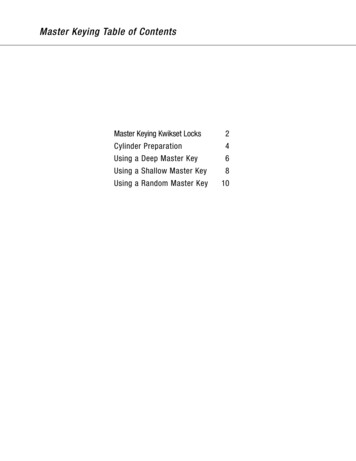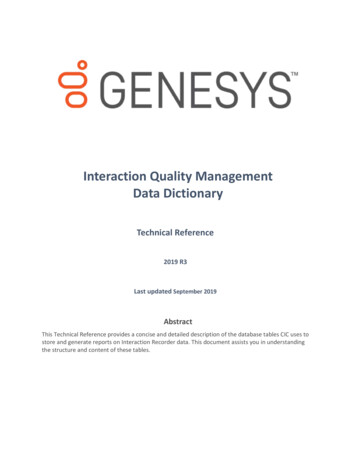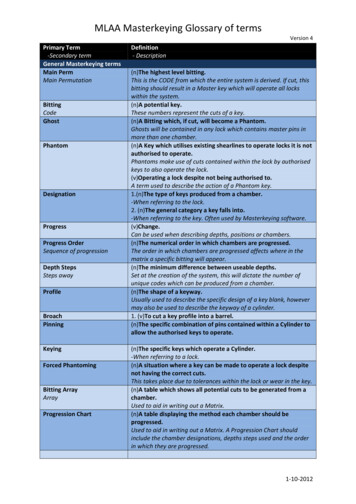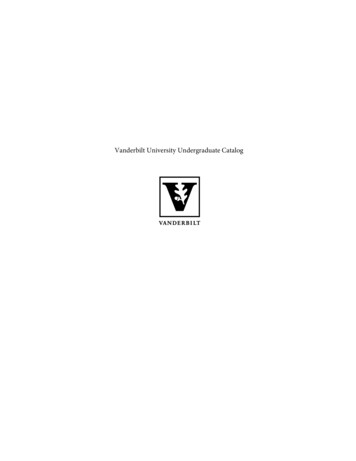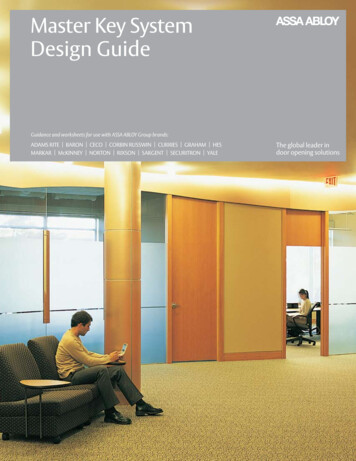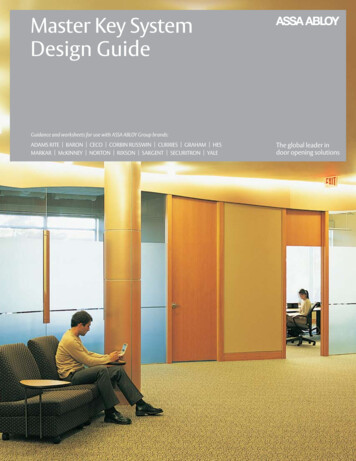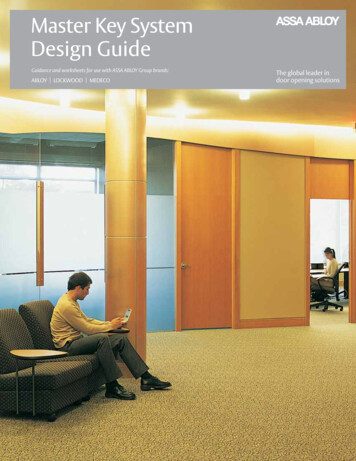
Transcription
Master Key SystemDesign GuideGuidance and worksheets for use with ASSA ABLOY Group brands:ABLOY LOCKWOOD MEDECO
IntroductionTable of ContentsTo ensure a facility or building has the desiredlevel of security, it is necessary to have a properlydesigned and maintained master key system. ASSAABLOY Australia offers all of the products andservices to help you implement a new master keysystem, or expand an existing one.PlanningKey System ProductsProduct solutions include:Convenience vs. Security,Achieving Proper Balance . . . . . . . . . 3System Structure . . . . . . . . . . . . 4Levels of Keying . . . . . . . . . . . . . 42-Level System . . . . . . . . . . . . . 53-Level System . . . . . . . . . . . . . 54-Level System . . . . . . . . . . . . . 5 Cylinders for various security requirements levels Cylinders that meet or exceed the AustralianStandard AS 4145.2 2008 Cylinders that work with electrified stand-aloneand networked access control systemsProfessional SupportOur team of trained Key and Door SpecificationSystem Specialists will help you design a securemaster key system, develop and implement keycontrol policies, select the right cylinder foreach doorway, and understand the latest trendsin physical security. As the leader in securityand safety solutions, ASSA ABLOY has the knowhow and expertise to assist with any securityrequirement for your premises.Key SymbolsStandard Key Symbols . . . . . . . . . . 62-Level System . . . . . . . . . . . . . 63-Level System . . . . . . . . . . . . . 6Grand Master Pie “A” . . . . . . . . . . . 74-Level System . . . . . . . . . . . . . 8Special Keying Requirements, Larger Systems . . 8System ExpansionDefine Expansion Parameters. . . . . . . . 9Sample Expansion Specification. . . . . . . 9What You Must Know . . . . . . . . . . . 9Theoretical Numbers Reduced . . . . . . . 9Design GuidesCross Keying . . . . . . . . . . . . . . 10Master Key System Design Guide: In additionto the support provided by our team, this designguide can help you plan and apply a master keysystem. It takes you through the entire processand includes a glossary of master key systemterms and worksheets to assist in the layout phase.Step by StepKey Control Guide: To extend the life and valueof a key system, correct key control policies mustbe in place. ASSA ABLOY offers a comprehensivekey control guide that will help you design policiesand procedures for your facility.Terms & Definitions . . . . . . . . .Learn MoreDesigning Master Key Systems . . . . .11-12Glossary and Keying Levels13-16Levels of Keying . . . . . . . . . . . . . 17System Design WorksheetSystem Design Worksheet (Level 3) . . . . . 18Sample System Design Worksheet (Level 3) . . 19Contact the Key System Specialist of your localASSA ABLOY Australia team to learn more aboutour products, services and training programs, andto get a copy of the Key Control Guide.2For assistance, contact your local ASSA ABLOY Australia team.
Careful planning is key to the long-term success and life of amaster key system. Planning starts with understanding theopposing forces of security and convenience, and creating theproper balance. From there, it’s easy to move onto developingthe key system structure.PlanningPlanningMaximum ConvenienceMaximum SecurityMaximum SecurityMaximum ecurityMinimumPersonalConvenienceSome buildings will be heavily security oriented. Lack ofconvenience may make it hard to operate the building ona day to day basisMaximumPersonalConvenienceSome buildings will require great personal convenience.This takes away from building security.Opposing ForcesThe cylinder mechanism and the keying system muststrike the right balance between two archrivals—securityand convenience.The type and amount of cross key, the use of keyed alikegroups and the number of levels of keying all play criticalroles in this delicate balance. They also directly affect theamount of expansion available in the system.“Security”“Convenience” Keyed to Differ sets Extensive cross keying Small, unrelated systems One huge,complicated system Patented keyways Security cylinders High security cylinders Key controlProper BalanceThe simplest keying systems are often the most secureand will last longer than complicated ones. Cross keyingand complicated systems reduce security and expansionpotential. A system designed around personnel will inevitablyhave a shorter life than that of a system designed around abuilding or structure.For assistance, contact your local ASSA ABLOY Australia team.BalancedBuildingSecurity Standard or non-protected keyway Many selective master keys No key controlBalancedPersonalConvenience3
PlanningPlanningSystem StructureBegin sketching out a key system schematic using descriptiveterms appropriate for the job at hand. Typically these wouldbe departments, buildings or geographic areas. It is notnecessary to account for every change key at this early stage.The schematic often looks like an organizational chart.When planning the system, don’t forget the building core.Core areas are generally maintenance areas: stairwells,mechanical rooms, electrical, phone and HVAC (Heating,Ventilation and Air Conditioning) areas. Normally, individualfloor or department masters DO NOT operate these areas.Group them all under their own MK (or use changes underthe grand, etc.).Key all similar core areas alike: one key symbol for all electricalareas; a second one for all pipe chases; a third for allmechanical rooms, etc. This reduces the need to issuemaster keys to maintenance personnel. Once the structure isdetermined, the next step is to determine the level of keying.SYSTEM WIDEADMINISTRATIONPRODUCTIONCORE AREASAREASAREASAREASLevels of KeyingFirst, we must understand theconcept of levels of keying. Thinkof it as levels of authority in anorganization. All systems shouldhave a structure like that of acorporate organizational MPLOYEEEMPLOYEEEMPLOYEEFor assistance, contact your local ASSA ABLOY Australia team.
2-Level SystemMKThe simplest master key system has two levels of keyingand is considered the lowest level of master keying. The lesspowerful keys at the bottom are called change keys. Each oneoperates only one lock, or one group of keyed alike locks. Themore powerful key at the top is called the master key.CKCKEven the largest, most complicated keying systems forhospitals and universities can be broken down into piecesthat fit this simple model.CK3-Level SystemGMKA 3-level system is nothing morethan two or more 2-level systemstied together under a higher levelkey called a grand master key.MKMKMKCKCKCKCKCKCKCKCKCK4-Level SystemGGMKA 4-level system ties two or more3-level systems together under ahigher level key called a great grandmaster key.Even though large jobs tend torequire more levels of keying thansmall jobs, most systems do notneed more than 4 levels of keying.In a 4-level master key system, it isespecially important to consider thetraffic flow throughout the building.For assistance, contact your local ASSA ABLOY Australia KCKCKCKCK5
Key SymbolsStandard Key SymbolsKey SymbolsA key symbol is an alpha and/or numeric (MK2, CK1, 1-1)designation that is used to properly identify the correctkey combination for a door or group of doors.2-Level SystemMKHere are a few rules to consider when designinga 2-level system:CK1Rule #1: Change keys have numbers added tothe letters or numbers of the master key they’reunder. In 2-level systems, it is these numbersthat come last.CK2CK33-Level SystemGMKIn systems with more than 2 levels, the changekey numbers come last. Here we have a 3-levelsystem, a grand master key system.6The change key numbers come last and themaster keys have 2 letters. The new item here isthe grand master key.MK1MK2MK3Rule #2: GMKs have only one letter or number.1-12-13-1Rule #3: Masters under the grand must startwith the letters MK.1-22-23-21-32-33-3For assistance, contact your local ASSA ABLOY Australia team.
Key SymbolsGrand Master Pie “A”A keying system is like a pie. You can cut it into many pieces,but the more pieces, the smaller each piece and the morethere is to manage.The larger you make one piece, the less remaining pie available.Key SymbolsKeep It SimpleMK15 MK16MK14MK1MK2MK13MK12MK3MK11MK4MK10MK9MK5MK8 MK7MK1MK2MK3MK4MK6Fewer masters: preferabledue to more expansionopportunitiesMany masters: “Top heavy”system with limited roomfor expansionThe following represents a schematic of a level three (GMK) system.Your system may vary somewhat from this.GMKGrand Master Key(MKGM) Housekeeping 1-1Security2-1HR3-1 to 3-5Storage1-2Lock Shop2-2IT3-6 to 3-10Roof Access1-3Access Control OverrideKD1ServiceMK4Electric Closet2-3Finance3-11to 3-15Phone Closet2-43-14 to MK6FuturePlan for 30 CK(5-1 TO 5-30)FutureFuturePlan for 30 CK(6-1 TO 6-30)GM-(NUMBER)President sOffice(Change underthe Grand)Cafeteria4-3 to 4-6Cleaner4-7 to 4-10Pipe Chases2-5For assistance, contact your local ASSA ABLOY Australia team.7
Key Symbols4-Level SystemGGMKIn a 4-level system (great grand master keysystem) the first 4 rules still apply: It’s a system of more than 2 levels,so the change key numbers come lastGMK1GMK2Key Symbols Masters have 2 numbers or letters The first number matches the grand Grands have a single numberThe new information here is the great grand.Rule #5: The symbol for a great grand masterkey is cial Keying RequirementsLarger SystemsThere are many other symbols for special keying requirements.Multi Profile keyways may be used to accommodate largersystems and expansion requirements necessary for futuredevelopment. Plan your largest systems wisely from the start;with the use of multi profile keyways the bittings are repeatedon other key sections. Let the manufacturer decide howto apply keyways to best suit the job at hand based on thenumerical expansion parameters.Selective Master Keys (ENG) Engineering key (CLR) Cleaners (SEC) Security keyChange Keys Under the Great Grand Master Key (GGMK) GGM1 - The first change key directly under the GGMK GGM2 - The second change key directly under the GGMK and so onChange Keys Under the Grand Master Key (GMK) GM-1 - The first change key directly under the GMK GM-2 - The second change key directly under the GMK and so on8For assistance, contact your local ASSA ABLOY Australia team.
System ExpansionAlways consider the expansion when designing master keysystems. A master key system is like a rubber band. Whenstretched vertically (more levels of keying) it contractshorizontally (fewer combinations at each level). Whenstretched horizontally (more combinations at each level)it contracts vertically (fewer levels of keying are available).Keep this in mind when designing keying systems andsubmitting expansion parameters to the manufacturer.Supply actual numbers for expansion under every masterlevel key, avoid using percentages.Define Expansion Parameters Realistic numbers at each level All branches of system Mixtures of cylinder mechanismsIn many cases, expansion is a guess, but it must be the bestpossible guess. Ask questions like these: How many more buildings in this system? How do future buildings fit into the structure?It’s absolutely critical for the health and longevity of the systemto establish realistic expansion parameters. See sampleexpansion specification section below and note that actualnumbers are shown for each level. What is the maximum number of keyed openings perfloor/department/areas that are keyed differently?Define realistic expansion for the number of masters undereach grand, and changes under each master for all parts ofthe system. If different cylinder mechanisms will be mixedon the project, define where each will be used. How do they fit into the overall system? Where does this job fit into the total final system?System Expansion Levels of keyingWhat You Must Know Are future buildings planned? What is the maximum conceivable number of keyedopenings on a floor after maximum partitioning? Will all cylinder mechanisms be under the same system?Sample Expansion SpecificationPlanning should include future building additions orpartitions, and rekeying individual door or groups of doorsif change keys or master keys are lost or stolen.Look as far into the future as possible, but don’t “go wild.”Stay realistic, and stay away from percentages.Theoretical Numbers ReducedThe master key system’s overall capacity is affected by thefollowing factors: Mechanical factors of cutting the key Establish a new grand master key system Theoretical numbers are first reduced by amechanical factor, called the MACS (MaximumAdjacent Cut Specification) Plan 20 changes directly under the grand Use of multiple selective keys Plan 10 master keys Cross keyingHere is an example of clear expansion parameters. Plan 50 changes each for each masterFor assistance, contact your local ASSA ABLOY Australia team.9
System ExpansionCross KeyingCross keying a cylinder allows additional keys other than itsown key set to operate it. There are two types of cross keying:controlled and uncontrolled. See the glossary beginning onpage 13 for additional information.Cross keying is always designated by the letter “X”: prefix X tothe key symbol, then list each key symbol that is required toalso operate the cylinder. Example: X1-1-01, OB (operated by)1-1-02,1-1-03,MK1,GMK.Cross keying: Should be avoided Does not fit in a system that has been designedfor securitySystem Expansion Normally results in unplanned key interchange Reduces the overall system capabilities Increases the risk of unauthorized key interchangeConvenience May Reduce Cylinder Security and HinderSystem ExpansionCross keying not only reduces security, it reduces expansionpossibilities. Uncontrolled cross keying (between differentmasters or grands) reduces it even more. If one master is lost,so are all of its changes. If one grand is lost, so are all of itsmasters and all of their changes. This can add up to thousandsof combinations lost. Therefore, supplying extra keys isrecommended rather than jeopardizing the integrity of themaster key system by allowing this convenience.An example of cross keying is when two or more different keyssuch as 1-1-01 and 1-1-02 are both required to operate thesame cylinder. This reduces the cylinder’s security. When thecross keying occurs under all the same higher level keys, suchas 1-1-01 and 1-1-02, it is known as controlled cross keying.When it combines keys under different higher level keys, suchas 1-1-01 and 1-2-01, it is known as uncontrolled cross keying.In addition to reducing the security of the cylinder, cross keyingusually imposes limits on the flexibility and expansion of theoverall keying system. This is especially true of uncontrolledcross keying. For these reasons, it is strongly recommendedto allow personnel to carry more than one key. Cross keyingshould be discouraged whenever possible. However, whencross keying is required, it is specified below, and should besummarized at the beginning of each order.10X1-1-031-1-2Office 1Receptionist1-1-1Office 2X1-1-03 operated by 1-1-2, 1-1-1, MK1 AND GMK.X1-1-03Case #1: Cylinder requires its ownchange key. The illustrationReceptionistdepicts part of a small medical building wheretwo doctorsshare a common receptionist. The receptionist gets the1-1-03 key. Each doctor carriesa key that1-1-21-1-1operates onlyone office, but is also cross keyed into the entrance fromthe corridor.Office 1Office 2Determine the X1-1-03symboloperatedof the changeThenthe letterby 1-1-2,key.1-1-1,MK1prefixAND GMK.X (example: X1-1-03). Then list all keys that are to operate in an“operated by ” phrase. Example: “X1-1-03 operated by1-1-2,1-1-1,MK1AND GMK”. Notethat X is a cylinder1-1-011-1-021-1-03specification only. The keys for cylinder X1-1-03 aredesignated1-1-03.1-11-1-041-1-051-1-061-1 operated by 1-1-011-1-06, MK1 -061-1 operated by 1-1-01 through 1-1-06, MK1 AND GMK.Case #2: Cylinder does NOT require its own change key. Thisillustration depicts a section of a floor in a dormitory. Eachstudent’s bedroom key operates the hall door lock. There is noneed to construct a key that operates only the hall door.In this case, place an X at both the beginning and end of thesymbol and a number between them. Example: X1X, X2X,etc. Again, always include the “operated by ” phrase with acomplete listing of key symbols to operate.For assistance, contact your local ASSA ABLOY Australia team.
Step by StepDesigning Master Key SystemsStep 1: Meeting Security ObjectivesDetermine the level of access for each opening requiringa cylinder.Here are the different types of cylinder mechanisms. Conventional “open & restricted keyways”- Not contract controlled- Key blanks are readily available Patented locking system- Administrative documents will be required betweenthe lock manufacturer and owner- Key blank distribution restrictions are in place Security (secondary locking mechanisms)- Provides resistance against picking and manipulation High security (Aust. Standard AS4145.2 2008 SC7 orgreater)- Provides resistance against picking / manipulationand drillingWhen access control devices are furnished with a keyoverride feature special consideration should be givenregarding its keying.- To facilitate multiple users through common doors Integrated locking systems (hardwired into accesscontrol systems)Step 2: PlanningEstablish the level of the master key system. The higher thelevel, the less secure.Before determining the level ask these very importantquestions: Who, if anyone, is authorized to carry the top master key? Who carries master keys and change keys? Level four – “Great Grand Master Key System”- Change key, master key, grand master key, and greatgrand master key With more levels, additional internal components arerequired in the cylinder. This increases the possibility ofunauthorized key interchangesSeparate internal departments in the building(s) intodepartments, buildings or geographic areas. Perimeter- Including all exterior doors, roof surfaces, gates andfences, and adjacent buildings Core Areas (Operations)- Sensitive areas crucial to daily operations, such as plantengineering, security and mechanical operations Management- Areas that are vital for daily business activities,including human resources, administration, executiveoffices, IT, and accounting Services- Areas that provide employees and visitors withservices, such as restrooms, medical treatment areas,housekeeping, food service, retail (unless it’s a leasedoutside source) Unique Applications- Door openings requiring access control hardwarewhere key override is required, or any other specialapplicationStep by Step Stand-alone access control locking devices (at door wiring)- Change key, master key, and grand master key Tenants- Any tenants that are not part of the building It is recommended to establish a separate system forthose areas requiring security type cylinder mechanismsContinued on next page Does every employee receive a key / do they need akey?Select the level: Level two – “Simple Master Key System”- Change key and master key only Level three – “Grand Master Key System”For assistance, contact your local ASSA ABLOY Australia team.11
Step by StepStep 3: Assigning Key SymbolsUse an alpha and/or numeric designation to properly identifythe correct key combination for a door or group of doors. Hereare some helpful hints:- Who will sign the work order? Lowest level possible- What records will be kept, and where?- Determine if the system is to be designed for securityor convenience (see page 1) Key alike within master key groups as much as possible- Avoid “top heavy” systems (example: few change keysused under numerous masters) Avoid cross keying, especially with patented lockingsystems and higherStep 4: Key Control andKey ManagementEstablish key hierarchy, key issuing policies and procedures,and administrative disciplines. What disciplinary action(s) will be put into placefor violations?Step by Step- What form of work order will be used to authorizecutting of keys? KISS “Keep It Simple System” Key to the building security objectives NOT to theconvenience of the keyholders- Fines or deposits What type of reports will be required?- Overdue keys- Mis-cut keys- Who receives the reports? Once a key has been cut, what instructions are givento the recipient?- Key receipt recommended Ensure that all transactions are recorded by the keycontrol authority ENFORCEMENT FROM THE START!Support and back those who are responsiblefor maintaining and servicing the systemStep 5: Service and MaintenanceFollow proper service schedules and procedures.Recommendations include the following: Utilize an in-house or outside locksmith- Lost keys- Ensure proper training- Keys not returned- Establish key cutting log- Will there be a key receipt required? Where will thatbe kept?- Establish service request procedures What is the role of the key control authority?- Authorized to purchase Have service equipment available- Key kit- Responsible for key control administration- Code cutter that complies with system’s depths andspacing specifications- Maintains key control software and all transactions- Locksmithing tools, fixtures and accessories Provide adequate quantity of keys- Top master keys - limit the number of these to only a few Establish stock levels and requirements to avoid misuseof multi-section key blanks- Master keys - also limit the number of these- Additional cylinders ready for emergencies- Change keys per key set and/or per keyed alike sets- Additional key blanks (of all keyways)- Special purpose keys; Control keys - limit the numberof these With whom or where will the key blanks be kept?12 Who is authorized to cut keys?Step 6: Intellectual Property Determine who will own the intellectual property orcopyright of the system design & code permutations.NOTE: See glossary on pages 13-16 for terms and definitions.For assistance, contact your local ASSA ABLOY Australia team.
GlossaryThis glossary relates to ASSA ABLOY Australia key systemseducation and should not be considered universal. Cylinderand Keying terminology has evolved over many years andwhile it is generally understood by those conversant with lockand key hardware, the accompanying glossary may assist toclarify any areas of doubt.1. Terms and definitions are to be reprinted in their entirety.2. Credit is to be given to Australian Standard AS 4145.12008, (Locksets and hardware for doors and windows.ACCESS CONTROLThe means by influencing and regulating the flow of persons througha doorwayALL – SECTION KEY BLANKThe key section that enters all keyways of amultiplex system.AUTHORIZED KEY CUTTERA business or person authorized by the lock cylinder manufacturer oragent to cut or bit that manufacturer’s or agent’s restricted keys.BARRELSee plugBITTED KEYGenerally means a cut key.BITTING1. The number(s) that represent(s) the dimensionsof the key.2. The actual cut(s) or combination of a key.BOWThe portion of the key that serves as a grip or handle.BROACHA tool used to cut the keyway into a cylinder plug or barrel. A term alsoused for the keyway shape.BUMPINGOne of many methods used to open locks with the use of “bump keys”that leave no sign of physical attack.For assistance, contact your local ASSA ABLOY Australia team.CHANGE KEYSee servant keyCOMBINATETo set a combination in a lock, cylinder, or key.CONSTRUCTION CYLINDERTemporary keyed cylinders installed during construction, removed andreplaced with final keyed cylinders after construction is complete. Thissystem ensures that keys used during construction cannot operate afterfinal cylinders are installed.CONSTRUCTION KEYINGAlternative method to a construction cylinder where the keyed cylindersare supplied with a construction key system when it is removed prior tobuilding completion by the insertion of the owner key or by the removalof a split key plug.CONSTRUCTION MASTER KEY (CMK)A key normally used by construction personnel for a temporaryperiod during building construction. It may be rendered permanentlyinoperative without disassembling the cylinder.CONTROLLED CROSS KEYINGA condition in which two or more different keys of the same level ofkeying and under the same higher level key(s) operate one cylinder bydesign. Note: This condition could severely limit the security of the cylinderand the maximum expansion of the system when (1) more than a few of thesedifferent keys operate a cylinder, or (2) more than a few differently crosskeyed cylinders per system are required.CREDENTIALSee Change KeyCROSS KEYINGThe process of combinating a cylinder (usually in a master key system)to two or more different keys which would not normally be expected tooperate it together. See also “controlled cross keying” and “uncontrolledcross keying.”CUT KEYA key that has been bitted or combinated.Glossary & Keying LevelsBITTING LISTA listing of all the key combinations used within a system. Thecombinations are usually arranged in order of the Bottom Pins andMaster Pins.CAMA rotating lever attached to the end of the cylinder plug to activate thelock mechanism.CYLINDERThe assembly incorporating the key-operated mechanism.CYLINDER CORESee plug13
GlossaryDIFFERSThe variation between locks of similar design, which allow each lock to beoperated only by its own key.DIRECT KEY CODINGA code marked on a key or locks which, with no reference to anotherseries of codes, discloses the key cuts for creating a workable key.DISCSee tumblerDOUBLE-BITTED KEYA key having bittings or cuts on two sides to actuate the tumblers ofthe lock.DUMMY CYLINDERA non-functional facsimile of a rim or mortise cylinder used for appearanceonly, usually to conceal a cylinder hole.INDIVIDUALLY KEYEDSee keyed to differKEYThe device that is intended to activate the lock mechanism or cylinder.KEY BITGenerally a cut in a key.KEY BITTING ARRAY (KBA)A matrix (graphic) display of all possible bittings for change keys and masterkeys as related to the top master key.KEY BLANKAn uncut key.KEY CABINETA cabinet with hooks, Velcro , or other means designed to store keyssystematically.EFFECTIVE DIFFERDifference between key mechanisms of similar design, achieved only bythe movable detainers, which allows each key mechanism to be operatedonly by its own key. The number of effective differs is equal to the numberof theoretical after deduction of the undesirables, suppressed by themanufacturer due to technical constraints.GRAND MASTER KEY (GMK)A key, within a system, that operates all locks in a number of separategroups that have their own Master keys.Glossary & Keying LevelsGREAT GRAND MASTER KEY (GGMK)The same as GMK but usually consisting of more than one GMK group,which are then controlled by one GGMK key.14GUEST KEYA hotel/ motel rook key that is used by a guest, usually keyed to differunder a master key group.KEY CHANGESThe number of differs available within a key system.KEY CODEA record of key bitting.KEY CONTROL1. Any method or procedure that limits unauthorized acquisition of a keyand/or controls distribution of authorized keys.2. A systematic organization of keys and key records.KEY INTERCHANGEAn undesirable condition, usually in a master key system, whereby a keyunintentionally operates a cylinder or lock.KEY PROFILEThe shape of the cross-section of the key that matches the broach.HIGH SECURITY CYLINDERA cylinder that offers a greater degree of resistance to any two or moreof the following: picking, impressioning, key duplication, drilling or otherforms of forcible entry.KEY SECTIONThe exact cross sectional configuration of a key blade as viewed from thebow toward the tip.HOUSING CYLINDERThe part of a locking device that is designated to hold a core.KEY SYMBOLA designation used for a key combination in the standard key codingsystem, e.g. GMK, MK, 1-1, etc.IMPRESSIONINGA method of determining the key cuts, using a key blank or similar device,inserted in the keyway.KEY SYSTEMSee maison key system, master key system and profile key system.INDIRECT KEY CODINGA code marked on a key or lock, which requires reference to another seriesof codes to disclose the key cuts for creating a workable key.KEY SYSTEM SCHEMATICA drawing with blocks utilizing keying symbols, usually illustrating thehierarchy of all keys within a master key system. It indicates the structureand total expansion of the system.For assistance, contact your local ASSA ABLOY Door Security Solutions team.
GlossaryKEYED ALIKE (KA)Indicates identical key for two or more locks.MASTER KEY1. A key that operates all the master keyed locks or cylinders in a group,each lock or cylinder usually operated by its own change key.KEYED DIFFERENT (KD)Of or pertaining to a group of locks or cylinders, each of which is or is to becombinated differently from the others. They may or may not be part of akeying system.2. To combinate a group of locks or cylinders such that each is operated byits own change key as well as by a master key for the entire group.KEYED TO DIFFERIndicates that a different key is needed to activate each lock.KEYED UNLOCKABLEIndicates that the locking operation is activated without the aid of a keyand the unlocking operation is performed by a key.KEYWAYThe opening in the plug that is shaped to accept a key blade ofproper configuration.KEYINGAny specification for how a cylinder or group of cylinders are or are to becombinated in order to control access.KEYING CONFERENCEA meeting of the end-user and the keying system supplier at which thekeying and levels of keying, including future expansion, are determinedand specified.KEYI
system, a grand master key system. The change key numbers come last and the master keys have 2 letters. The new item here is the grand master key. Rule #2: GMKs have only one letter or number. Rule #3: Masters under the grand must start with the letters MK. Standard Key Symbols A key symbol is an alpha and/or numeric (MK2, CK1, 1-1)
